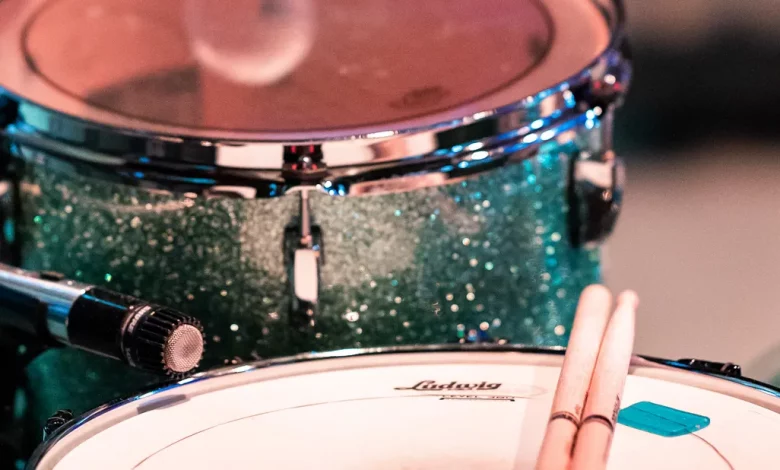
We may earn a commission from the affiliate links on this site. Learn more›
There’s no reason to spend hundreds, if not thousands, of dollars to get a better drum sound. Sometimes, you only need a few easy ‘hacks’ to make your cheap drum set sound pro. This guide will give tips to get the most out of your inexpensive set without breaking the bank.
Let’s dig in!
Quick List
- Invest in some new heads
- Tighten your hardware
- Tune-up
- Wax your bearing edges
- Remedy those nasty overtones
- Get a new set of cymbals
- Replace snare wires
- Install a kick drum port
- Experiment with sticks
Invest in Some New Heads
One of the first places to start is with the heads.
New drumheads can elevate your sound, no matter what state your cheap drum set is in.
Of course, with infinite options, finding the best drumheads to replace your old battered drumheads can be a challenge.
The important thing here is to determine what you want from your drumhead. For example, relatively thick drumheads are better equipped for heavier drumming styles, such as rock, metal, or punk. A thicker 2-ply drumhead might be your best bet.
Finding the best drumheads can take years of trial and error, so we recommend starting with some classics, such as the Evans EMAD Heavyweights or Remo Pinstripes.
Tighten Your Hardware
Before you install your new drumheads, take some time to inspect and tighten up your internal hardware. Check out the mounting hardware for your lugs or other accessories, such as air vents or tom mounts.
Most of your hardware will have washers attached, which, if not adequately tightened, can rattle each time you play the drum. Again, depending on your hardware, you may only need a Philips head screwdriver, a flat head, or a socket head.
Tighten up each screw so that there is minimal friction. The key here is to never over-tighten your hardware, as doing so can ruin the resonance of your shells.
Tune-Up
It can seem like a mundane or time-consuming effort if you’ve never tuned your drums before.
However, in our experience, the payoff is well worth it. Not only will your kit sound better, but you’ll also develop the skills to tune more accurately and efficiently, which can be helpful when playing live or recording.
We have an in-depth article that covers everything you need to know about tuning your drums if you want to learn more.
Wax Your Bearing Edges
Waxing your bearing edges might sound complicated, though it’s pretty simple.
All you need is some high-quality wax (beeswax is my favorite), which you can rub over each bearing edge to reduce the amount of friction between the shell and the head. Keeping your bearing edges waxed will improve the head vibration and contact.
Adjust the Beater
You don’t need to go out and buy a new beater to get it to sound good. Instead, you can perform some simple adjustments to maximize your bass drum’s tone and resonance. First, ensure the beater on your bass pedal strikes as close to the drum’s center as possible.
If you play a 22″ bass drum, getting your beater to hit center can be pretty straightforward. On the other hand, if you play a 20″ or 24″ bass drum, you might find it more challenging to get your beater to hit dead center. In this case, you can adjust the beater rod’s height. However, note that doing so will sacrifice the responsiveness of your pedal, so finding the best balance is crucial.
Luckily, if you have a smaller drum, many manufacturers have introduced bass drum risers, which raise drums a few inches higher off the floor, allowing your beater to hit dead center.
Remedy Those Nasty Overtones
There are times when even proper tuning can’t deal with complex overtones, which are often present in cheap drums. Luckily, with a bit of intuitive dampening, they aren’t difficult to deal with.
There are different ways to approach dampening depending on the drum:
Bass Drum
Many people reach for blankets or pillows to stuff inside their bass drums, which is often good enough. It is essential to experiment with how much your muffling materials come in contact with the resonant heads, as it can significantly impact the sound.
Snare Drum
Most of the time, I like to let my snare drum sing. However, there are also times when a little bit of intelligent dampening can go a long way.
If you’re sick of taking your wallet out of your back pocket to plop on your snare drum head during gigs, get yourself a set of Moon Gels.
While they might be a little pricey in the grand realm of dampening products, there’s truly nothing better out there.
However, a little duct tape can provide an excellent alternative if you’re on a tight budget.
Toms
I often experiment the most with toms when it comes to dampening, as there are so many unique tones you can conjure up. Of course, if you tune your tom well, you may not need to dampen them. However, a bit of sustain can be pleasant, especially on your floor tom.
Moon Gels and O-Rings can help cut down on unwanted overtones and sustain if you want a drier, 70-style tom sound. Remember to look at your bottom resonant heads, as this is where a fair amount of the sustain comes from.
Get a New Set of Cymbals
Many cheap drum sets come with cymbals, though most sound about as good as metal trash can lids and are even less durable.
Nothing can make or break the sound of a drum set quite like cymbals, and if they sound horrid, not even your replacement heads or dampening techniques will be able to save you.
A good set of cymbals can certainly be an investment, though if you’re going to invest anywhere, this is undoubtedly the place to start.
While they aren’t the cream of the crop, most major cymbal manufacturers offer cymbal starter kits, which often come with a crash, a ride, and a set of hats. However, you can usually pick these up for a few hundred bucks.
Replace Snare Wires
If you’re dealing with a worn-out snare drum head, it’s likely the case that the wires need replacement as well. Unfortunately, many drummers never replace their snare wires, which is ironic because they profoundly impact the tone.
Determining whether or not you need to replace your snare wires is as simple as snapping your throw-off to the off position and analyzing them when they’re in slack. If you notice any damage on the individual strands, bending or warping, or crossing over one another, it’s time to get yourself a new set.
If you’ve never changed your snare wires before, you may be overwhelmed by the variety on the market. This is one time I’d recommend taking your snare drum to a local shop where the drum tech can advise you on picking the best set of snares based on your tonal preferences.
Install a Kick Drum Port
Installing a kick port is one of the most popular ways to accentuate the punchiness of a kick drum. In addition, kick ports allow for better venting so air can flow freely, and the drum can resonate more naturally.
When your resonant head interferes with the air pressure too much, your kick drum can sound like a basketball.
With a port, you get a punchier, more resonant tone. The added benefit is more straightforward recording. You can place your kick drum microphone so that it’s aimed at the port to capture the full resonance of your drum.
Experiment with Sticks
You may be surprised at how vital a role sticks can play in your drum tone. When looking for new sticks, look at the tip material:
- Nylon tips are harder and produce a brighter tone
- Wooden tips are softer and produce a more natural, muted tone
Also, consider the various tip shapes:
- Round tips maintain a crisper and brighter sound that is very articulate
- Oval tips are a bit more versatile, suited best to darker and warmer tones
- Barrel tips are great for loud and punchy tones
- Teardrop tips produce richness and warmth
- Acorn tips deliver a full and fat tonal response
- Arrowhead tips are great for fatter tones and pulling complex overtones out of your cymbals
Buy a couple of sticks and experiment with the different options until you find the right ones.
Final Thoughts
At this point, you should have a cheap drum set that sounds a hundred times better than the day you got it. Now, it’s time to keep it that way.
Creating a routine maintenance schedule for your drums will ensure they’re always in the best shape possible. From tuning your drums to cleaning the heads to oiling the hardware, many methods of simple maintenance can provide you with longevity, so you can have a great-sounding kit for years to come.
Keep your drum set from sinking to the level of your local venue’s house kit, which has gone through years of mistreatment, neglect, and spilled beer. Instead, give it the care it needs and let it inspire you each time you sit down to play.



